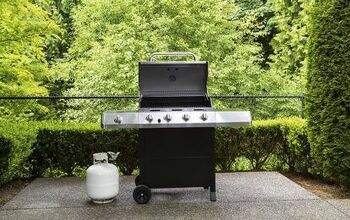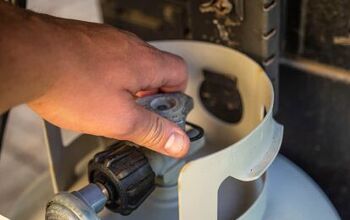How To Read A Propane Tank Gauge (Quickly & Easily!)

Most people assume that when they read the gauge, whatever they read is an accurate reflection of the volume of substance they’re measuring. Let’s say when your car’s gauge tells you that the tank is half full, that’s what you can expect it to be. So, it may come as a surprise to learn that not every gauge is the same, and you shouldn’t expect this degree of accuracy when dealing with propane gas tanks. So, what is the correct way to read a propane tank gauge?
You must understand what the numbers mean when reading your propane tank gauge. The gauge will reflect the percentage of propane in your tank and not the number of gallons. Additionally, when your propane tank is full, it will read 80%, not 100%. From there, multiply the number of gallons by the gauge’s percentage to get a feel for how much propane is left.
Reading a propane tank gauge is not as cut and dry as one would think. That’s why we’ve put together this guide to help teach you the correct way to read the gauge. That way, you don’t run the risk of your propane tank fully emptying and posing potential problems.
Learn How To Read Your Propane Tank’s Gauge
If you already use propane in your home, you’ll have a storage tank located on your property. This could hold anything between 120 and 1000 gallons, especially if the gas is your primary heating fuel and powers appliances such as dryers. If it’s not visible, it’ll be located somewhere below ground.
Regardless of how big your propane tank is, it will have a gauge to indicate the level of gas in the tank. This will be essential in helping you to plan your next delivery in good time and avoid the inconvenience you run out. However, as the reading on your propane tank gauge will be different from that on your car’s gas gauge, it’s essential to understand how they differ and to know the correct way to read it.
How To Read A Propane Tank Gauge
There is one key thing to bear in mind when reading your tank gauge – it only tells you the percentage of your full tank. It does not tell you the number of gallons you have left. You need to keep in mind that when your tank is full, the gauge will read 80% and not 100%. 80% will always be the maximum percentage. Why? Because stored propane is liquid, it needs to have space to expand and contract with every temperature fluctuation.
For example, if your gauge reads 25, it means that your tank is 25% full. With a 120-gallon tank, this would mean that you have 30 gallons of propane remaining. With a 500- gallon tank, you’d have around 125 gallons. This will help you estimate essential information, such as:
- How long your supply will last
- When you’ll need to refill
- The cost of delivery
Propane Gauge Chart
Below is a chart that helps compare the amount of propane in your tank to the gauge reading. We’ve included readings for tank sizes from 120 gallons to 1,000 gallons. Feel free to use this comparison chart when reading your gauge.
Gauge Reading (Percentage) | 120 Gallon Tank (Gallons Left) | 250 Gallon Tank (Gallons Left) | 500 Gallon Tank (Gallons Left) | 1,000 Gallon Tank (Gallons Left) |
80% | 96 | 200 | 400 | 800 |
70% | 84 | 175 | 350 | 700 |
60% | 72 | 150 | 300 | 600 |
50% | 60 | 125 | 250 | 500 |
40% | 48 | 100 | 200 | 400 |
30% | 36 | 75 | 150 | 300 |
20% | 24 | 50 | 100 | 200 |
10% | 12 | 25 | 50 | 100 |
The Importance Of Knowing How To Read Your Gauge
Monitoring your propane storage tank gauge and taking prompt action when refills are needed will avoid some issues which may result when your tank is empty. Once your propane supply has run out, your furnace won’t work – this can present a significant problem in colder areas in the depth of winter when it may also take longer for deliveries to arrive.
- Letting your tank empty out can be dangerous. Even more severe than these obvious inconveniences are the safety issues which can be created when you allow your tank to be empty. For example, after the refill, a gas leak may result if a valve has inadvertently come open. In addition, a pilot light may be extinguished. As this can be dangerous, you’ll need to be aware of this when it happens and address the issue to avoid any safety risks.
- You will need to pay for leak testing before refilling an empty tank. You should be aware that federal regulations require leak testing is carried out when a storage tank has been emptied. This is not a free test, and you, as the homeowner, will be required to pay for this service.
- It will keep you safe and save you money. Knowing how to read the simple gauge on your propane tank will save money, frustration and, most importantly, keep you safe. It only takes a few seconds and a simple calculation to keep things running smoothly.
What If My Propane Accidentally Runs Out?
Should a gas line or valve remain open when the gas supply runs out, a gas leak can result when the tank is refilled. Also, due to the air and humidity that can enter, there may be a build-up of rust inside the tank. It’s essential to be aware that rust can also make it more difficult to detect the smell of propane.
You may notice a powerful propane smell even when your tank is empty. This is due to the odor collecting in the base of the container and becoming concentrated. This can be present several serious risks. Fires and explosions resulting from a pilot light becoming extinguished can cause severe damage and loss of life.
Different Propane Tank Sizes
There are various options when selecting a propane tank. The most important consideration when choosing the size of your propane storage tank is how much you need to do with it. A 120-gallon tank will be sufficient in a typical home if you’re just cooking and heating water. However, in a large house, or if you’re using propane as your primary power source, a 500-gallon tank will be more suited to your needs.
Other typical uses for propane include:
- Cooking
- Pool heating
- Generators
- Gas Heaters
- Gas Appliances
The advantage of a 120-gallon tank is that it can be installed horizontally or vertically. Larger models must be horizontal. Of course, if you feel a tank would be an eyesore, or you don’t have space in your yard, there is always the option of a below-ground installation.
Related Questions
Are propane tank gauges reliable and accurate?
Whenever your valve is open, the gauge will provide a reading. It may not be 100% accurate, but if gas is passing through it, the needle should reflect the changes. A needle that drops indicates a gas leak. Should this happen, disconnect the tank immediately and do not use it until the installation has been checked by a professional and repaired.
Is there a specific type of gauge for propane tanks?
There are various types of gauges for propane tanks. Inline gauges are installed between the gas line for the appliance and the tank’s cut-off valve. Their readings are based on pressure and will indicate whether the tank is full, low, or close to empty.
How does a magnetic propane gauge work?
When the liquid gets cold enough, the tank next to the liquid gets colder than the tank next to the air above the liquid level. The magnets just measure the temperature of the tank rather than directly measuring the actual liquid level.Magnetic gauges don’t measure the volume of liquid inside the tank. They only measure the temperature of the air inside the tank.
Wrapping It Up
Knowing how to read your propane tank’s gauge is convenient for you and something you should know how to do for safety reasons. Allowing your tank to empty can pose a variety of risks to your tank and, in worst-case scenarios, your life. Knowing how to read your tank’s gauge can prevent any costly fixes, damage to your tank, and potential loss of life.
It’s better to spend a few seconds reading a gauge rather than handling the problems of an empty propane tank. If you’re worried about miscalculations, you can always compare your gauge reading to the percentage and size of the tank you have using the chart above.

Heather is a passionate writer who loves anything DIY. Growing up, she learned everything from home repairs to design, and wants to share her tips with you. When she's not writing, she's usually hiking or searching for her next DIY project.
More by Heather Robbins



























